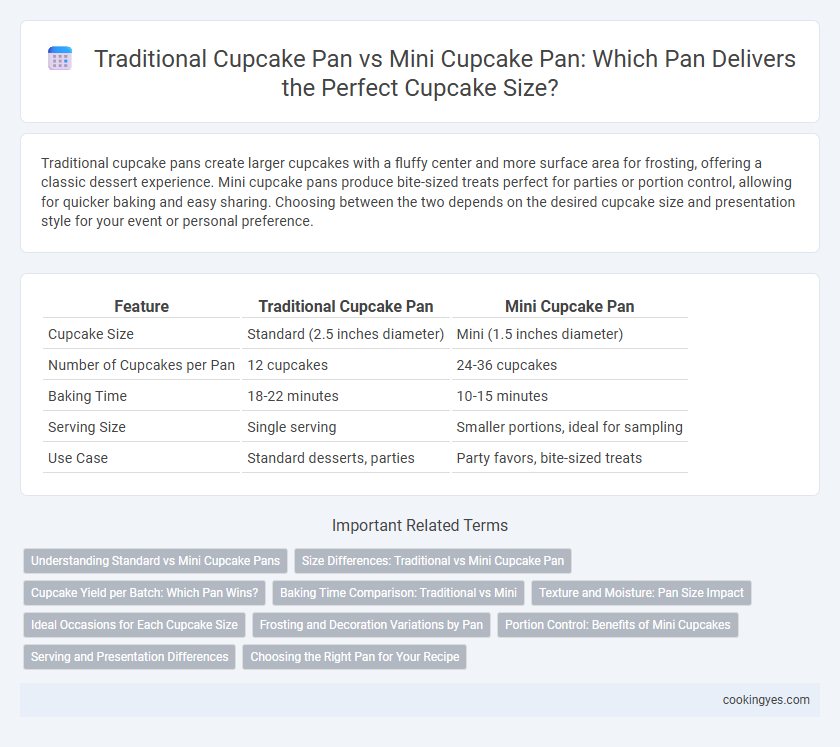Traditional cupcake pans create larger cupcakes with a fluffy center and more surface area for frosting, offering a classic dessert experience. Mini cupcake pans produce bite-sized treats perfect for parties or portion control, allowing for quicker baking and easy sharing. Choosing between the two depends on the desired cupcake size and presentation style for your event or personal preference.
Table of Comparison
| Feature | Traditional Cupcake Pan | Mini Cupcake Pan |
|---|---|---|
| Cupcake Size | Standard (2.5 inches diameter) | Mini (1.5 inches diameter) |
| Number of Cupcakes per Pan | 12 cupcakes | 24-36 cupcakes |
| Baking Time | 18-22 minutes | 10-15 minutes |
| Serving Size | Single serving | Smaller portions, ideal for sampling |
| Use Case | Standard desserts, parties | Party favors, bite-sized treats |
Understanding Standard vs Mini Cupcake Pans
Standard cupcake pans typically hold 12 cups with a capacity of about 3.5 ounces each, producing classic-sized cupcakes ideal for decorating and serving. Mini cupcake pans usually contain 24 cups with a smaller capacity of approximately 1.5 ounces per cup, perfect for bite-sized treats at parties or sampling different flavors. Choosing between standard and mini pans depends on desired portion size, baking time variations, and presentation preferences.
Size Differences: Traditional vs Mini Cupcake Pan
Traditional cupcake pans typically hold 12 standard-sized cupcakes, with each cup measuring about 2.5 inches in diameter, producing larger, more filling cupcakes suitable for standard servings. Mini cupcake pans generally have 24 cups, each approximately 1.5 inches in diameter, resulting in smaller, bite-sized treats ideal for parties or portion control. The size difference affects baking time, with mini cupcakes requiring less time to bake compared to traditional cupcakes due to their smaller volume.
Cupcake Yield per Batch: Which Pan Wins?
A traditional cupcake pan typically produces 12 standard-sized cupcakes per batch, ideal for classic servings and frosting decoration. In contrast, a mini cupcake pan yields about 24 smaller cupcakes, doubling the output and perfect for bite-sized treats or party platters. When prioritizing cupcake yield per batch, the mini cupcake pan wins by providing higher quantity with less batter per cup.
Baking Time Comparison: Traditional vs Mini
Traditional cupcake pans typically produce larger cupcakes requiring 18-22 minutes of baking at 350degF, while mini cupcake pans yield smaller cupcakes that bake faster, usually within 10-15 minutes. The reduced size in mini pans allows for more even heat distribution and quicker batter cooking, minimizing the risk of undercooked centers. Choosing the appropriate pan affects not only cupcake size but also precise baking time, essential for achieving optimal texture and flavor.
Texture and Moisture: Pan Size Impact
Traditional cupcake pans produce larger cupcakes with a denser texture and often retain moisture more effectively due to slower baking times. Mini cupcake pans yield smaller, lighter cupcakes with a slightly crisper exterior and a quicker bake that can sometimes reduce overall moisture content. Selecting pan size directly influences the cupcake's crumb structure and juiciness, impacting the eating experience.
Ideal Occasions for Each Cupcake Size
Traditional cupcake pans create standard-sized cupcakes ideal for birthday parties, family gatherings, and casual celebrations where guests prefer a satisfying single serving. Mini cupcake pans produce bite-sized treats perfect for cocktail parties, baby showers, and events requiring easy-to-eat desserts that encourage variety and sharing. Choosing the right pan enhances presentation and convenience, aligning cupcake size with the event's formality and guest preferences.
Frosting and Decoration Variations by Pan
Traditional cupcake pans create larger cupcakes, offering ample surface area for elaborate frosting designs and intricate decorations. Mini cupcake pans produce bite-sized treats, which limit frosting space but encourage bite-friendly, minimalist decoration styles. Choosing between pans depends on the desired presentation, with traditional pans favoring artistic frosting swirls and mini pans emphasizing colorful, simple toppings.
Portion Control: Benefits of Mini Cupcakes
Mini cupcake pans offer precise portion control, making it easier to manage calorie intake and serving sizes compared to traditional cupcake pans. Each mini cupcake typically contains fewer calories and less batter, promoting moderation without sacrificing flavor. This size advantage supports dietary goals and reduces food waste by providing perfectly portioned treats.
Serving and Presentation Differences
Traditional cupcake pans typically hold 12 standard-sized cupcakes, offering a classic serving size ideal for individual portions at parties or events. Mini cupcake pans produce smaller cupcakes, usually 24 per pan, perfect for bite-sized servings and elegant presentation on dessert trays or buffets. The choice influences not only serving quantity but also visual appeal, with mini cupcakes providing a more delicate and versatile option for diverse occasions.
Choosing the Right Pan for Your Recipe
Traditional cupcake pans typically hold 12 cupcakes with a standard size of about 2.5 inches in diameter, making them ideal for classic recipes requiring consistent baking times and even heat distribution. Mini cupcake pans produce smaller, bite-sized cupcakes, usually around 1.25 inches in diameter, perfect for party favors or portion-controlled treats but may require shorter baking times and careful monitoring to prevent overbaking. Selecting the right pan depends on your recipe's yield, the desired cupcake size, and the baking time adjustments necessary to achieve the perfect texture and appearance.
Traditional Cupcake Pan vs Mini Cupcake Pan for Cupcake Size Infographic

 cookingyes.com
cookingyes.com